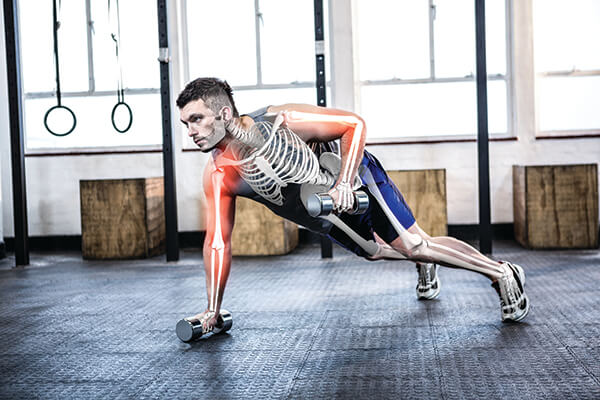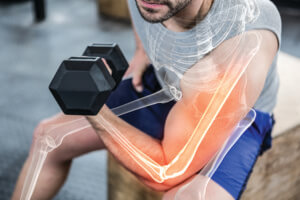To keep your skeletal structure strong and supple, try these 7 steps, including exercising daily and buying a quality mattress

Editor’s note: Savvy mattress retailers want to do everything they can to help their customers sleep better, including offering them sound advice and tips. Feel free to share this great guidance from Better Sleep Council spokeswoman Lissa Coffey with your shoppers (with credit given, of course). The BSC is the consumer education arm of the International Sleep Products Association.
People sometimes say “I need to rest my weary bones” when they feel tired. Studies show that we should take this phrase literally.
Researchers from the Medical College of Wisconsin in Wauwatosa, Wisconsin, found that sleep helps to strengthen bones. Their study of lab rats showed that a lack of sleep interrupted new bone formation, while existing bone density decreased. When it came to the rats’ bone marrow, scientists found a decrease in the fat component and an increase in the cells that generate platelets. What does all this mean? The rats in the study experienced greatly diminished flexibility and more fragile bones.
Another study from China looked at the association between less sleep and lower bone density in middle-age and older women, and discovered a correlation. And a study in Norway found that those suffering from insomnia experienced a 52% increased risk of osteoporosis, a condition that causes bones to become weak and brittle.
To maintain healthy bones, our bodies must be able to go through a bone remodeling cycle. The process also is vital to keep the body flexible so we can avoid fractures. With our usual activities, we recover from normal bone wear quickly. However, when sleep deprivation interferes with bone remodeling, bone density may decrease and we can become less flexible, more prone to fractures and more susceptible to osteoporosis. There’s no doubt that sleep is essential for bone health.
But here’s the problem: Osteoporosis is associated with aging. And as we get older, it can be more difficult to get the good night’s sleep we need. One reason is that as we age, the production of melatonin, also known as the “sleep hormone” because it impacts sleep, decreases. The body produces melatonin based on the amount of light we are exposed to. Getting some sunlight during the day helps the body to produce melatonin at night. The combination of lower melatonin levels that come with age and inadequate sleep can put us in a downward spiral that accelerates bone loss.
We can’t avoid aging, and we can’t control some of the other risk factors for osteoporosis either. They include:
O Gender: Women are more likely to get osteoporosis, particularly after menopause.
O Ethnicity: White and Asian people have a higher risk for osteoporosis than other ethnic groups.
O Height: People 5 feet, 7 inches or taller and those who weigh less than 125 pounds have an increased risk of osteoporosis.
O Heredity: People with a family history of osteoporosis or a diagnosis of a hip fracture are more at risk of developing the disease.
O Previous history: Those over the age of 50 who have had previous fractures from low-level injuries are more likely to be diagnosed with osteoporosis.

Fortunately, there are many things we can control to fend off osteoporosis, including staying active and mobile. And there are steps we can take to make sure we get the good sleep our bones require to remain healthy. Here are seven:
1. Increase melatonin. Besides helping with sleep, melatonin functions as an antioxidant, reducing damage caused to bones from activity and free radicals in the environment. It also can help us to heal from fractures and surgeries. While we can become dependent on melatonin supplements, there are many other natural options to help amp up our melatonin production. To start, get some sunlight every day, and sleep in a dark or dimly lit room. You also can add melatonin-rich foods to your diet. Sunflower seeds, alfalfa sprouts, almonds, eggs, goji berries and tart cherries are a few examples.
2. Exercise every day. Just 10 minutes of aerobic exercise can help you to sleep better at night. Be sure to exercise during daylight hours and not too close to bedtime because you need time to recover and relax afterward. Weight-bearing exercise has been shown to be beneficial for bone health. Weighted vests for walking are a safe way to exercise without overdoing it. Yoga helps to increase flexibility and balance, reducing the risk of falls and fractures.
3. Get sufficient minerals and vitamin D. Magnesium has been hailed as a sleep aid and is great for building strong bones. Calcium, iron and zinc also help to protect against osteoporosis. Vitamin D aids the absorption of calcium, so it plays a key role in fighting osteoporosis. You can get vitamin D from exposure to sunlight and also from saltwater fish, liver or fortified foods.
4. Avoid alcohol and tobacco. We know that drinking alcohol at night interferes with sleep, but did you know that alcohol also is linked to lower bone density? Tobacco is a culprit, too. Avoid these substances as much as possible.
5. Maintain a healthy body weight. Obesity is associated with sleep apnea, which disturbs sleep.
6. Get screened. Talk with your doctor about getting an osteoporosis screening. Osteoporosis comes on slowly and you might not be aware you have it until you break a bone. When identified early, osteoporosis can be treated effectively before it causes fractures.
7. Purchase a good mattress. And lastly, make sure you sleep on a comfortable, supportive mattress. No two bodies are alike; we all have unique bones. When shopping for a mattress, rest-test each one by stretching out as you normally would while sleeping. Your mattress is an important ally in helping you to get the sleep you need to protect your bones.

Lissa Coffey is a spokeswoman for the Better Sleep Council and the founder of CoffeyTalk.com. A lifestyle and wellness expert, she’s written several books and has been a frequent guest on national and local television shows.







